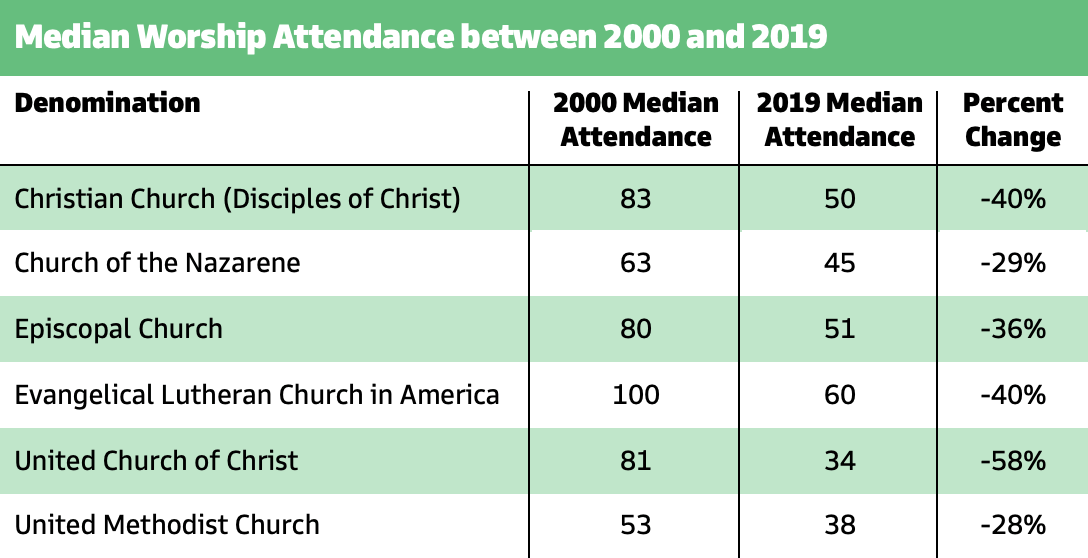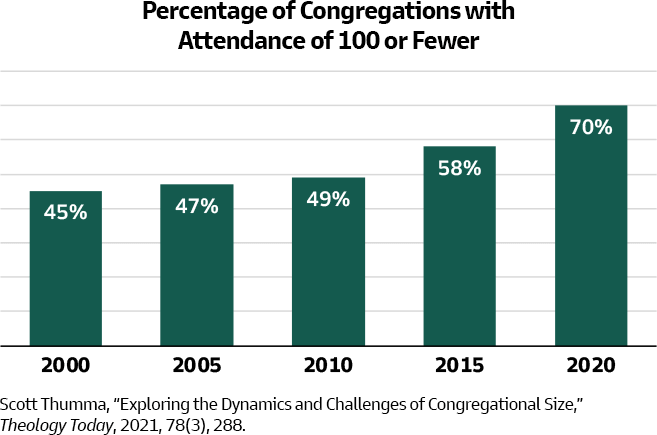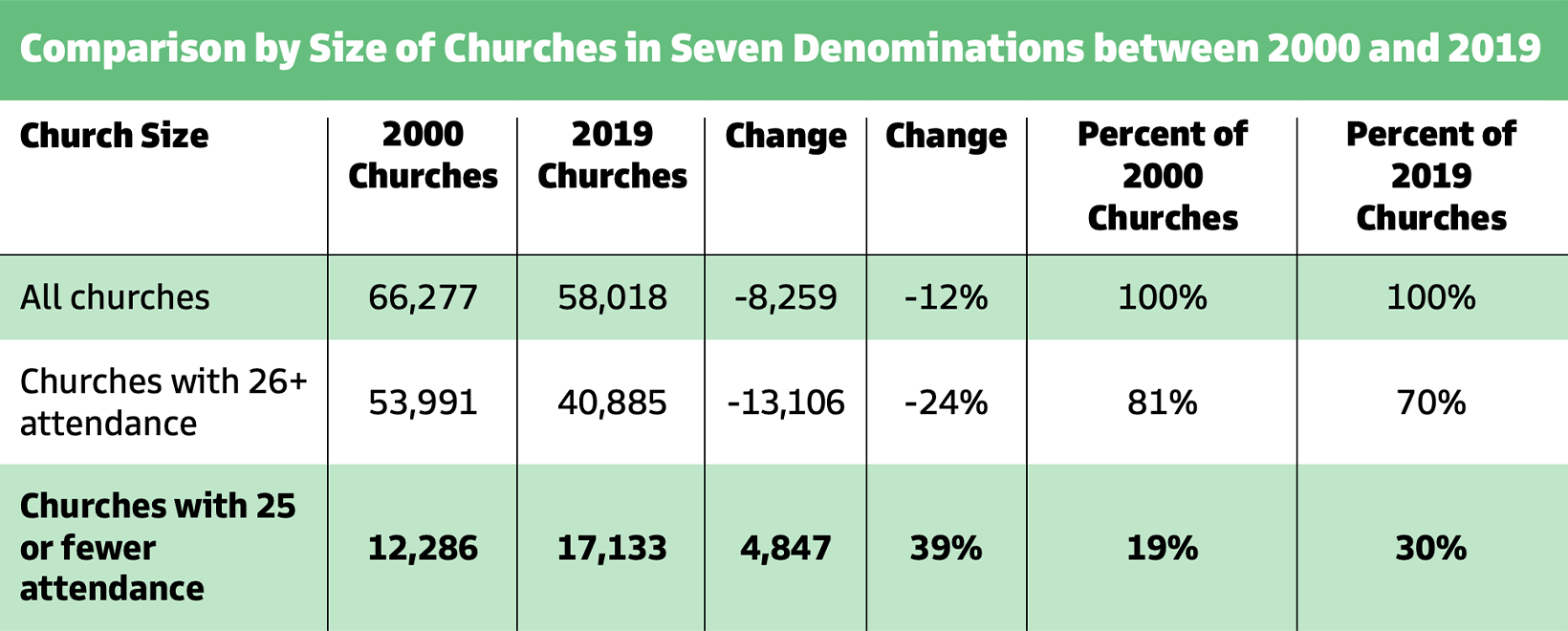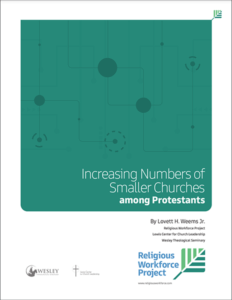The percentage of U.S. churches with attendance of 100 or fewer increased from 45 percent in 2000 to 70 percent in 2020. Lovett H. Weems Jr. shares relevant data while also considering the distinctive calling of very small congregations and ways they can embrace a more positive future.
The Religious Workforce Project of the Lewis Center is a multiyear effort to understand the changing religious landscape in the 21st century. Funded by the Lilly Endowment, Inc., the project explores how congregations are adapting, especially in their workforce. This article is part of a series featuring insights from the research. The full research reports on which these articles are based are available at the project website.
“Most congregations are small, but most people are in large congregations.” This statement by sociologist Mark Chaves captures the dominant trends in church size and attendance patterns over several decades. According to the National Congregations Study (NCS) that Chaves directs, the 9 percent of churches with 360 or more participants have half of worshipers. Likewise, the 91 percent of congregations with fewer than 360 participants have the other half of worshipers.
What, then, is the future for small and very small churches? And what are steps toward discovering their distinctive callings? First, church leaders at all levels of responsibility need to recognize the statistics illustrating the current sizes of congregations throughout the United States.
One can see the shrinking size of most Protestant churches by reviewing the declines in the median worship attendance (half of churches have higher attendance and half smaller attendance) in recent years among these denominations for which the Lewis Center’s Religious Workforce Project had data.

Attendance declines mean there are increasing numbers of smaller churches each year. Faith Communities Today reports that the percentage of U.S. churches with attendance of 100 or fewer increased from 45 percent of congregations in 2000 to 70 percent in 2020.

The accelerating pace of worship declines is producing significant increases in the number of small churches. For example, an analysis of Southern Baptist churches by Lifeway Research indicates that in 2022, 46 percent of churches had fewer than 50 in attendance. That percentage had been 36 percent as recently as 2017. Then there is the growth in the number of the very smallest churches, those with 25 or fewer worshipers on average.
Higher numbers of very small churches
The Religious Workforce Project compared how the numbers of churches by average worship attendance (AWA) size groups changed between 2000 and 2019 in seven denominations. The denominations included are the Christian Church (Disciples of Christ), Church of the Nazarene, Episcopal Church, Evangelical Lutheran Church in America, United Church of Christ, United Methodist Church, and Wesleyan Church. While changes may vary in traditions not included, among this sample, there are significantly more very small churches, with 25 or fewer average attendance, than in 2000. Twenty years ago, churches with 25 or fewer attendance represented only 19 percent of these denominational churches. By 2019, they comprised 30 percent of the churches.

We see not only that the majority of churches remains small, but they are also becoming much smaller than most congregational and denominational leaders have faced in their lifetimes. One might think that the death or merger of the smallest congregations would keep some type of balance to the size makeup of churches. Surely churches are closing, but churches typically do not close at high rates. Some are talking today, however, about a rash of church closings considering the declines cited here and the impact of the pandemic. That may, indeed, turn out to be the case.
What, then, is the calling of very small congregations? What can they do?
1. Remember that there have always been small churches.
From biblical times until now and across the globe, small groups of people form congregations. They usually worship and serve effectively while never having large numbers of people. Protestant churches in the United States have typically been small because of the pattern of rapid church growth in the late 19th and early 20th centuries as the nation was predominantly rural. One difference and limitation for U.S. small churches today compared to the past is that now small churches are far less likely to be multi-generational than in the past.
2. Celebrate what small churches do very well.
Smaller churches normally have higher rates of attendance compared to their available constituents than larger churches. Likewise, per capita giving percentages tend to be higher among smaller churches. While this dedication does not tend to produce enough people or resources in most cases, it is an example of love and commitment for your church that should be celebrated by members and leaders beyond the congregation and is a foundation on which you can build.
3. Make changes necessary to stabilize finances.
A church’s operating expenses should be covered by recurring and predictable income. Depending on nonrecurring income for basic operations is a danger sign. Examples of these nonrecurring funds are accumulated savings, bequests, or the sale of assets. Such funds are best used for capital needs to make the church stronger for the future. Congregations depending on nonrecurring funds for operations are merely delaying a crisis. Seeking information from similar-sized churches about both their income sources and expenses may result in ideas about how to rethink the scope of your spending and income.
4. Identify one pressing community need that matches a congregational strength.
Have conversations with those who may have more knowledge of your surrounding community. Talk with those who deal regularly with people in the community you do not know, including those that do not go to church. Identify some of the greatest needs in the community. Then select one for which your church has a passion and some relevant strengths. For example, some churches have well-kept facilities. Others have open spaces. Still others may have a history of mission, strong music, or a cadre of retired teachers. Find a concrete way to reconnect with your community to serve. Always keep in mind that revealing question, “If your church closed today, who would miss it other than the members?”
5. Connect with other churches of similar size.
The challenges you face are not unique to your congregation. Chances are that other churches in your area are facing similar questions. Establishing conversations to learn from one another will build relationships out of which shared ministries may emerge. For example, the community need you hope to address may be larger than your church alone can handle.
As church attendance declines and worship patterns change, and the numbers of small and very small congregations are increasing, the call for witness and service in their communities is all the more crucial.
 Related Resources
Related Resources
- Doing Community Ministry in the Small Church by Joy F. Skjegstad
- The Soul of a Small Church by Lewis A. Parks
- The Case of a Small Church in an Oversized Building by Lewis A. Parks
- The Religious Workforce Project






